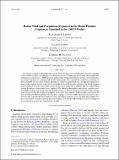| dc.contributor.author | Barnes, Elizabeth A. | |
| dc.contributor.author | Solomon, Susan | |
| dc.contributor.author | Polvani, Lorenzo M. | |
| dc.date.accessioned | 2017-03-15T19:53:00Z | |
| dc.date.available | 2017-03-15T19:53:00Z | |
| dc.date.issued | 2016-06 | |
| dc.date.submitted | 2015-08 | |
| dc.identifier.issn | 0894-8755 | |
| dc.identifier.issn | 1520-0442 | |
| dc.identifier.uri | http://hdl.handle.net/1721.1/107425 | |
| dc.description.abstract | The volcanic eruption of Mount Pinatubo in June 1991 is the largest terrestrial eruption since the beginning of the satellite era. Here, the monthly evolution of atmospheric temperature, zonal winds, and precipitation following the eruption in 14 CMIP5 models is analyzed and strong and robust stratospheric and tropospheric circulation responses are demonstrated in both hemispheres, with tropospheric anomalies maximizing in November 1991. The simulated Southern Hemisphere circulation response projects strongly onto the positive phase of the southern annular mode (SAM), while the Northern Hemisphere exhibits robust North Atlantic and North Pacific responses that differ significantly from that of the typical northern annular mode (NAM) pattern. In contrast, observations show a negative SAM following the eruption, and internal variability must be considered along with forced responses. Indeed, evidence is presented that the observed El Niño climate state during and after this eruption may oppose the eruption-forced positive SAM response, based on the El Niño–Southern Oscillation (ENSO) state and SAM response across the models. The results demonstrate that Pinatubo-like eruptions should be expected to force circulation anomalies across the globe and highlight that great care must be taken in diagnosing the forced response as it may not fall into typical seasonal averages or be guaranteed to project onto typical climate modes. | en_US |
| dc.description.sponsorship | National Science Foundation (U.S.). Climate and Large-Scale Dynamics Program (Grant 1419818) | en_US |
| dc.description.sponsorship | National Science Foundation (U.S.) (Grant 1419667) | en_US |
| dc.language.iso | en_US | |
| dc.publisher | American Meteorological Society | en_US |
| dc.relation.isversionof | http://dx.doi.org/10.1175/jcli-d-15-0658.1 | en_US |
| dc.rights | Article is made available in accordance with the publisher's policy and may be subject to US copyright law. Please refer to the publisher's site for terms of use. | en_US |
| dc.source | American Meteorological Society | en_US |
| dc.title | Robust Wind and Precipitation Responses to the Mount Pinatubo Eruption, as Simulated in the CMIP5 Models | en_US |
| dc.type | Article | en_US |
| dc.identifier.citation | Barnes, Elizabeth A., Susan Solomon, and Lorenzo M. Polvani. “Robust Wind and Precipitation Responses to the Mount Pinatubo Eruption, as Simulated in the CMIP5 Models.” Journal of Climate 29.13 (2016): 4763–4778. © 2016 American Meteorological Society | en_US |
| dc.contributor.department | Massachusetts Institute of Technology. Department of Earth and Planetary Sciences | en_US |
| dc.contributor.mitauthor | Solomon, Susan | |
| dc.relation.journal | Journal of Climate | en_US |
| dc.eprint.version | Final published version | en_US |
| dc.type.uri | http://purl.org/eprint/type/JournalArticle | en_US |
| eprint.status | http://purl.org/eprint/status/PeerReviewed | en_US |
| dspace.orderedauthors | Barnes, Elizabeth A.; Solomon, Susan; Polvani, Lorenzo M. | en_US |
| dspace.embargo.terms | N | en_US |
| dc.identifier.orcid | https://orcid.org/0000-0002-2020-7581 | |
| mit.license | PUBLISHER_POLICY | en_US |
